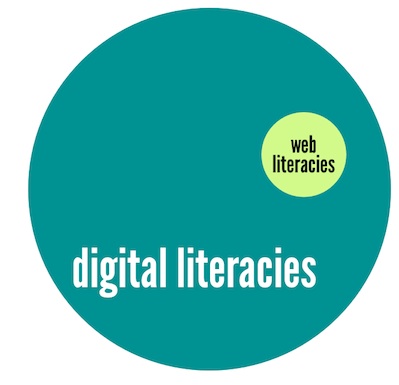Digital Literacies and Web Literacies: What's the Difference?

I’m currently iterating some work around Web Literacies for the Mozilla Foundation (you can see the latest version of my thinking here). Perhaps the biggest consideration when dealing with so-called ‘New’ Literacies is distinguishing them from one another. As I've discussed many times before, without some clear thinking on this issue both theorists and practitioners alike tend to talk past one another using imprecise terminology. What I want to consider in this post is the relationship between Digital literacies and Web literacies. Aren’t they just synonyms?
The topic of digital literacies was the focus of my doctoral thesis, which is available to read online at neverendingthesis.com. The conclusion I came to after delving deeply into the research was that we need to always talk about literacies in their plurality and that there are broadly eight essential elements to digital literacies. My question when it comes to Web Literacies, therefore, is whether (a) they constitute a subset of Digital Literacies, (b) they are wholly distinct from Digital Literacies, or (c) there is some overlap between the two. These three positions are represented by the graphic at the top of this post.
Let’s take the middle position first, as it’s perhaps the easiest to dismiss. If Digital Literacies and Web Literacies were wholly distinct from one another, then there would be no overlap between the practices they contain. This is patently false, as demonstrated by even the briefest examination of the eight essential elements of Digital Literacies I have identified:
1. Cultural
2. Cognitive
3. Constructive
4. Communicative
5. Confident
6. Creative
7. Critical
8. Civic
The Web is not only (as Cory Doctorow puts it) a giant ‘copying machine’ but it’s also one of the greatest methods ever devised for individuals and groups of people to interact with one another. In other words, the Web is inherently communicative. It also allows for human flourishing on a unprecedented scale through allowing human beings to be creative. And, as we have seen through its use for the Occupy movement, many people use the Web for important civic actions.
Given just these three examples, it’s obvious that Digital Literacies and Web Literacies at least overlap in some ways. The question to address now is to what extent they overlap. An easy way to do this would be to compare definitions of Web Literacies and Digital Literacies. Unfortunately, as this is a contentious area, to do so may be problematic. This was the reason why I avoided definitions in my thesis. Another approach might be to look at the essential elements of Web Literacies and compare those with the essential elements of Digital Literacies.
Building on the work of my colleagues at the Mozilla Foundation I’ve been looking at five different elements of Web Literacies:
- Exploring
- Authoring
- Connecting
- Building
- Protecting
Without going into too much detail here (a forthcoming White Paper around Web Literacies by me will do this) I think it’s safe to say that it’s possible to map these five essential elements of Web Literacies onto the eight essential elements of Digital Literacies. Just as an example, ‘Protecting’ the Web correlates strongly with the ‘Civic’ element. Likewise ‘Authoring’ the Web correlates with the ‘Creative’ element.
If Web Literacies are wholly situated within Digital Literacies then our diagram looks like the following: 
This not only appeals to common sense but is consistent with my work in both areas. What remains an open question, and which I would greatly desire some feedback and opinions upon, is whether Web Literacies constitute either (or both) a necessary condition for Digital Literacies? In other words, could somebody claim to have developed Digital Literacies without having developed Web Literacies?
I’m fairly sure you can guess my answer. :-)